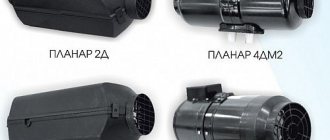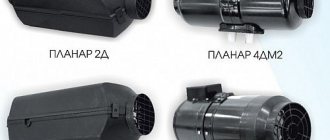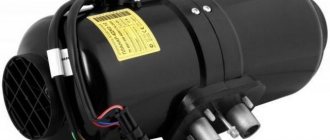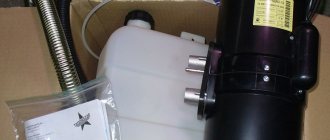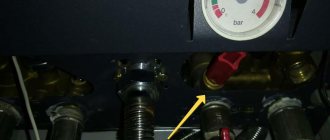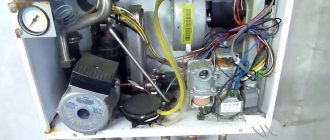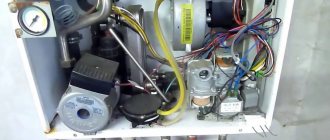Device
The design of the Planar autonomous system includes a power regulator with a rotary handle, as well as a timer that serves to automatically turn off the device after prolonged operation.
The device is designed in such a way as to ensure autonomous operation at all stages. Automation also monitors the state of each internal element in the current period. Ignition begins only if the control system verifies that all compatible components are in working order. This solution allows you to achieve the highest level of operational safety of the device.
Among all the components of a heating device of this type, several main parts can be distinguished:
- A unit with a control panel is required to control the equipment as a whole.
- The fuel pump serves to supply the required amount of fuel to the working chamber.
- The heating element is necessary to heat the air, which then enters the cabin.
Installation kit and technologies
The Planar heater kit includes all the necessary elements for successful installation of the device on a car. Please note that the installation kit includes a large number of parts and assemblies that are imported high quality products. For example, a fuel pump, which is a plunger type pump, a reliable electric motor, a glow plug, an overheat sensor, a flame indicator, etc.
In addition to the installation kit itself, the device comes with technical documentation, which contains comprehensive information on how to correctly install the autonomous heater and connect the device if you need to install it yourself.
The only thing is that if you install it yourself (not in a specialized service that has certificates for carrying out such work), problems with the warranty may arise. This must be taken into account in order to fully maintain the manufacturer’s warranty obligations.
If we summarize the information, then the list of main advantages of Planar air heaters includes:
- reasonable cost;
- low fuel consumption;
- sufficient performance;
Also noteworthy is the presence of a heater auto-diagnosis function, the ability to select an operating mode taking into account the power or temperature in the cabin. At the same time, reduced energy consumption is observed when the device is operating with the internal combustion engine turned off.
Another thing worth mentioning is the low noise level, since the design uses a brushless motor developed by domestic specialists. The combustion chamber in the new generation of devices is also manufactured using a patented unique technology.
The device is convenient to service, since the housing design is designed to simplify access and disassembly during service. All connectors are sealed, which prevents moisture from entering, oxidation or destruction of electrical contacts.
Features and causes of malfunctions of Eberspacher heaters
Eberspacher heaters are known for their reliability and ease of use. For many years now, there have been few competitors in the Russian market in terms of quality. However, problems can sometimes arise with such autonomous heaters. Most of them are corrected in the same way as those described above. Don’t forget that Eberspacher autonomous vehicles have a self-diagnosis module. It issues a numeric 3-digit code that starts with 0xx. According to the fault codes presented below, you will find out the reasons and how to fix problems in different components of the Eberspacher heater.
Eberspacher fault codes
The combustion sensor reports temperatures above 80 °C.
Planar heaters: purpose, operating principle and features
So, the Planar autonomous air heater allows you to quickly warm up the air in the cabin or inside the car, as well as maintain the set temperature with maximum efficiency. The required heating and its intensity are programmed by the user using special device controls.
The presence of an autonomous heater makes it possible to constantly maintain the required temperature in a bus, van, passenger car, truck cabin, etc. in case of lower outside temperatures. In some cases, maintaining the same temperature may be a prerequisite for transporting various goods safely or in proper presentation (for example, transporting flowers in a van, medicines, etc.)
The operating principle of the heater is that the device takes fuel from the main tank of the vehicle. It is also possible that the heater has its own separate power supply system. This solution assumes the presence of an independent fuel line and a separate fuel tank.
In terms of installation, the device can be installed in the cab or under the hood. Air can be taken from outside, and operation in recirculation mode is also possible. In this case, air is taken from the car interior, after which such air passes through a heat exchanger, the temperature of such air rises and then the heated air flows back.
In air recirculation mode, you can quickly and efficiently warm up the interior or cabin, and also maintain the maximum temperature, provided that the outside air temperature is very low.
We also recommend reading the article about which is better, Hydronic or Webasto, as well as which of these heaters is preferable for one reason or another. From this article you will learn about the features of these devices and their installation, service, warranty policy, repair, etc.
We also note that in the warm season the device can be used as additional ventilation for the interior, since it is possible to realize an intensive intake of outside air for high-quality airflow. Among the main advantages are high performance simultaneously with low fuel consumption. It is also possible to increase the resource of the power unit, since the heater operates completely autonomously.
If the car is used in European countries, the presence of a heater that meets Euro-3 environmental standards eliminates possible problems that often arise in the event of existing restrictions on parking a car with the engine running.
Specifications
Let's consider the popular model 4DM 12 24. This is also a planar autonomous vehicle. Its price is 19,400 rubles. The device is a diesel autonomous heater. The device has the following technical characteristics.
Thus, the level of heat production is 3 kW in active mode, and 1 kW in low mode. Fuel consumption in active mode is 0.36 l/h. In low mode, the device consumes up to 0.12 l/h. Power consumption - up to 30 W. Injected air – 120 m3/h. The supply voltage is 12 and 24 V. All these characteristics were measured at rated supply voltages and a temperature of 20 degrees. There may be a slight measurement error.
Features and benefits
The “Planar” autonomous vehicle is manufactured in Samara at the “Advers” enterprise. The company is engaged in the production and sale of various climate control equipment, which is in great demand in Russia. The main advantage of the company's products is affordable prices and high quality equipment.
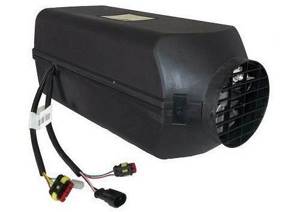
Autonomous heaters can perform their functions efficiently and reliably even at outside temperatures down to -45°C. Also among the advantages of the device is its compact size. The heater will not take up much space in the car interior. The use of the device is greatly simplified due to the fact that the system is equipped with a remote control. Using it, you can turn the device on and off, as well as change various battery modes.
All products that are manufactured have the necessary certificates that fully confirm safety and compliance with quality standards. The Planar autonomous vehicle consumes a small amount of fuel during operation, which ensures a long period of use. Installation can be done independently. This allows you to save significantly.

Also, another important advantage that the Planar autonomous vehicle has is the price. For a diesel model with a power of 7.5 kW it is 28,300 rubles. This is much lower than the cost of similar products from European manufacturers.
Errors Planar 4DM2-12-S / 4DM2-24-S
| Code | Number of LED flickers | Problem | Reason for error |
| 13 | 2 | The device does not start after two attempts. | There is no fuel in the tank. The quality of the fuel does not meet the conditions of use in cold weather. |
The air intake or exhaust pipe is dirty.
Poor heating of the glow plug, failure of the control unit.
The impeller is in contact with the volute in the air blower, due to which insufficient air is supplied.
Contamination of the hole in the combustion chamber (diameter - 2.8 mm). Contamination of the spark plug grid or incorrect installation in the fitting (not all the way).
Error codes
The self-diagnosis function, built into the control system of the autonomous heater "Planar" of various modifications, allows you to determine the area and cause of the malfunction. Information is provided to the driver in the form of error codes and flashing indicator lights on the remote control.
Decoding the most common error codes for Planar brand heaters.
| Fault code | Number of indicator light blinks | Malfunction | Cause of malfunction |
| 1 | 1 | Heat exchanger overheating | The control sensor detected overheating and turned off the heater. The reason is that a temperature of over 250 °C was recorded in the area of the heat exchanger. |
| 13 | 2 | The number of possible launches has been exhausted | The reason is problems with fuel: it is missing, its brand does not match, insufficient supply due to clogging or leakage of the fuel line, problems with glow plugs, insufficient pressure of air entering the combustion chamber |
| 2 | 12 | Overheating in the area of the control unit or flame indicator sensor | The temperature in the location area exceeds 50 °C. Overheating of the control unit during operation or during the purge period before starting operation the control unit was not cooled. |
| 4 and 6 | 6 | Failure of the temperature sensor of the control unit | The temperature sensor has failed |
| 5 | 5 | Flame indicator fault | Short circuit or open circuit in the indicator power supply |
| 8 | 3 | Flame interruption | Leaking fuel line, broken flame indicator or fuel pump |
| 9 | 4 | Glow plug malfunction | Short circuit, open circuit, malfunction of the heater control unit |
| 10 | 11 | Insufficient air blower speed | Fan failure |
| 12 | 9 | Voltage over 30 V, emergency shutdown | Battery or regulator malfunction |
| 15 | 9 | Insufficient voltage, emergency shutdown | Malfunction of the battery or regulator, broken wiring |
| 16 | 10 | The combustion chamber ventilation interval has been exceeded | The flame indicator was not cooled down during purging; there was a problem in the heater control unit |
| 17 | 7 | Fuel pump malfunction | Open or short circuit in the electrical power supply circuit of the fuel pump |
| 20 | 8 | Lost connection between control unit and remote control | Broken electrical wiring, faulty remote control or control unit |
| 27 | 11 | The electric motor does not work | Electric motor wedge due to destruction of the bearing, rotor or foreign objects |
| 28 | 11 | The motor runs at constant speed | Malfunction of the control unit or board on the control unit |
| 36 | 20 | Flame sensor temperature exceeded | Control unit malfunction |
How does an autonomous heater work? Repair, diagram, malfunctions
Why are we all talking about signaling, this topic is also relevant, it’s freezing outside, it’s time to pick at this miracle device with frozen hands or just throw knowledge at unknown crap.
The video will tell and show the insides of the battery, the animation will help you understand the operating algorithm, and you will have a chance not to fucking freeze.
No duplicates found
Automotive community
12.2K posts 33.8K subscribers
Community Rules
Welcome to the automotive community!
We prohibit:
-Publication of videos on the subject of road accidents (exception: original content with description).
-Break the rules of the site.
-Create posts that do not correspond to the topic of the community.
-Advertise anything.
-Accordions are not advisable (ignoring the accordion meter is punishable by flugegeheimen).
-Brew chamomile tea in a giraffe costume.
We are allowed:
-Create interesting content.
-Participate in the life of the community.
-Suggest topics for posts.
-Call the administrator or community moderators if necessary.
-Express ideas to improve the Automotive Community.
-Image a horse when commenting.

You're right, I'll leave a comment for the cons.
such x. have not seen for a long time. It’s easier to tell with your fingers and you’ll understand more in 5 minutes than to watch it, it’s packaged for “people” with a higher education in a field like “nuclear chemistry”, the picture is more elementary and clearer
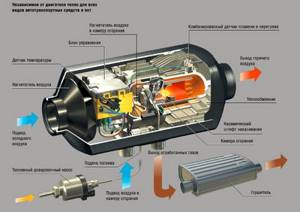
The guys from the channels for professional car repairs wrote in the comments that the video is good, the video has the largest number of views on my channel, there are a lot of double views, so I don’t think everything is very bad, and the video is not for beginners, but it finds its viewer, I think you’ll come to it You will come back more than once, since the autonomous system requires not only components, but also a circuit diagram, operating algorithms, typical faults, and troubleshooting methods.
By the way, I also have a course on condominiums, take a look and evaluate it.
The first video is 11 minutes, five minutes overview of the components, the rest is how the circuit works, I don’t know where it is for half an hour.
no offense. 2nd minus
This is a diagram, not reality. 3rd
people want to see the working circuit “live” and what it consists of, as well as the causes of possible breakdowns. For example, Webasta has 9 failure errors, Eberspächer has more than 90, Planar about 30, Breeze about 20, Pramotronic
xs (but before it was necessary to call the priest with their jambs with the ecu) think in the future about a more detailed description of either breakdown options, their elimination and diagnosis, or a more visual video about the components “live” and their work
Thank you for your detailed comment, this video is one of the very first, now it’s getting better, I’m making it shorter and with more live examples, the diagram will always be there because in real life it’s just a bunch of jumbled wires, it’s difficult to lay something out evenly, and I don’t have such opportunities now to turn around and show the components of the car, although in the last videos about the signaling I made a stand and showed a little in real life, now I make separate videos on malfunctions, but in general I plan to switch to 3D, but I need a new computer, Monique, and force myself to learn new programs, now 5 I use programs to make a video, all free. As for making specific models with their parameters and problems, it will be possible, there will be a real device in hand and analysis, circuits, measurements of resistance, voltage, current, etc., but for now I have about 20 more topics, about 50 videos will be released from them, and this takes me about two years, one video takes a week of hard work, searching, checking information, drawing with the process of coming up with what and how it will be located, animation, voice acting with coming up with text on the go and moving the pointer across the screen, editing this fucked up into a digestible video format, posting on YouTube with writing down names, tags, drawing pictures on the poster, and answering questions in the comments, then spreading it across the Internet to drive, VK, Pikabu. , a bunch of other little things
Autonomous car "Planar": reviews
Among users, especially those who spend a lot of time on the road, the device in question is popular. Car owners note the ease of installation and maintenance, reliability and low cost compared to foreign analogues.
Consumers especially highlight the following advantages of the device:
- The ability to route air ducts into the cargo area, which allows heating not only the cabin, but the entire vehicle.
- High operating efficiency even in frosts down to -20 degrees.
- Economical consumption of fuel and battery life.
- Acceptable power parameter.
- Unlimited operating life of the device.
01/20/2016 19:00:49 Monitoring the operation of the Autonomous system and the Hairdryer Planar, Promotronic.
- dyama2007
- Wialon fan club
- Inactive
- From: Vladivostok
- Registered: 07/10/2014
- Messages: 487
- Products: Wialon HostingWialon ProWialon Local
- Karma: 51
Re: Monitoring the operation of the Autonomous system and Hairdryer Planar, Promotronic.
The goal is to control maximum fuel consumption without additional sensors. Write off fuel based on engine hours during a trip, engine hours in a parking lot, “motor hours” of a hair dryer, “motor hours” of an autonomous vehicle.
Autonomy consumes 1l. at one o'clock. The hair dryer consumes 0.5 liters per hour.
The devices are connected directly to the battery as indicated in the passport. For example Planar-44D-12/24 RE.
When turning on and operating the heater, malfunctions may occur. In this case, the heater control unit automatically sends a command to turn off the heater. Each fault that occurs is coded and automatically displayed on the indicator (see Fig. 6.7). In this case, the fault code and the LED indicating the heater operating mode will flash rarely.
If I understand correctly, you can measure the voltage at the heater pump. There is power - it works, no power - it doesn’t work.
I’m also thinking about taking pulses or voltage on the LED; if it works properly, it lights up, otherwise it blinks.
Do you think this can be implemented?
there are pulses on the pump, if you remove it from the LED, you need to disassemble the control panel. It’s easier, I think, to remove the signal from the pump because... it works throughout the entire operating cycle of the boiler; if there is an error, the pump will also not work. I need to think about the hairdryer
Advantages and disadvantages
The device can work autonomously when the car engine is turned off
The Planar heater helps out many drivers. Truckers, bus drivers, and travelers are forced to spend a lot of time in the car cabin. In the cold season, heating the interior due to engine operation is insufficient. Planar solves this problem.
- In an hour, the heater, depending on its power, heats from 34 to 120 cubic meters. m. air.
- The planar is economical - with such high efficiency it consumes no more than 29–42 W. The same volume of heated air requires from 0.24 to 0.37 liters of diesel fuel per hour.
- Planar is effective at very low temperatures outside – below -20 C.
- The installation works without time restrictions. Automatically turns off when the specified temperature is reached and turns on when it drops. You can turn off the device manually.
There are no disadvantages. Autonomous car heater Planar fully corresponds to its purpose.
The heater is used not only in cars, but also for heating cabins, vans, booths, and tents.
Malfunctions and their elimination
The organization of searching for defects is described in the operating instructions for the device. Malfunctions that arise during operation and require complete or partial disassembly of the heater must be carried out by specialists from repair organizations. All faults, except the inability to turn on the heater, are indicated by a blinking LED on the control panel.
Error codes
The heater is equipped with a monitoring system for the proper operation of components and individual elements. If a defect occurs, the automation classifies it and notifies the driver by the number of LED flashes. The list of possible malfunctions is summarized in a table indicating the necessary actions to be taken to restore the device to operability. Error codes correspond to the number of blinks of the indicator.

Malfunctions are collected into 10 groups based on the same causes of occurrence and methods for eliminating defects. The table is given in the heater operating manual.
You can find out about the error by the indicator on the timer-thermostat or control panel.
Timer error codes:
- E-01 – malfunction of the starting system
- E-02 – no flame ignition
- E-03 – low voltage
- E-04 – malfunction of the flame indicator
- E-05 – malfunction of the power supply
- E-06 – temperature sensor does not work correctly
- E-07 – solenoid valve malfunction
- E-08 – fan motor malfunction
- E-09 – electric pump problems
- E-10 – high voltage
- E-20 – no connection between the control unit and the timer-thermostat
On the control lamp, the same errors are identified by the number of blinks, and their number corresponds to the error code. For example, if the indicator blinks 4 times, then there is a malfunction in the flame indicator circuit (E-04).
If error E-20 occurs, the indicator lamp will not blink.
Error codes on the control panel are indicated by a sound and light signal: the indicator begins to flash red. The number of times the sound and color signals are the same, for example, the error code corresponds to 02 flashes of the indicator and 2 sound signals.
Error codes: 01 - flame failure 02 - no ignition 03 - high voltage 04 - low voltage 05 - temperature sensor failure 06 - flame indicator circuit failure 07 - electric pump failure 08 - solenoid valve failure 09 - burner motor failure 10 - problems in the high-voltage source voltage 11 – no connection with the control unit 12 – thermal fuse trips 13 – fuel heater transistor is broken
Why doesn't it start
If, when you try to turn on the heater, the LED indicator does not light up and the start-up does not occur, then there may be several reasons for this situation, but they are all related to a lack of power:
- 25 A fuse blown;
- faulty electrical wiring;
- The contacts in the connectors have oxidized.
If there is power to the control panel, the cause of the malfunction may be a defect in any of the controlled elements. In this case, the defect code will be shown by a flashing indicator.
How to turn it on
Starting and changing operating modes of the “autonomy” are carried out from the control panel. To start the heater, you need to select a program using the mode key (3 or 8 hours) and turn on the power switch. The LED will light up and the control unit will begin executing the program. After testing is completed and the blower, pump and fuel pump are turned on, the burner will ignite. The program runs automatically and does not require driver intervention. At the end of the set time, the device will stop.
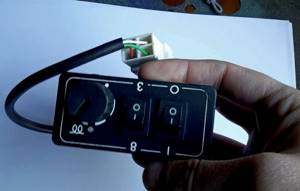
Restart is possible after a power failure; its subsequent activation - no earlier than after 10 seconds.
Control panel design
The remote control is used to manually control the heater modes, to extend the operating time, as well as to turn it on and off.
Remote panel drawing:
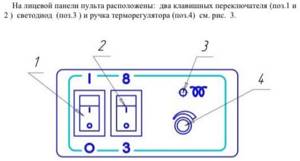
One switch is used to turn on/off, the second to control operating modes.
The thermostat knob is used to regulate cabin heating, which is carried out when the coolant temperature is above 55°C.
If the LED indicator is flashing, then there is a malfunction in the preheater; stable lighting indicates that the system is working
Repair
Despite the fact that the manufacturer recommends repairing breakdowns associated with disassembling an autonomous heater in specialized workshops, many drivers and car owners prefer to fix the faults themselves. The fairly high price of the work pushes them to this decision.
Most often, the flame sensor fails and the fuel line becomes clogged. The work is simple and does not require the use of special tools.
Regular scheduled maintenance will help reduce the number of defects.
For this type of heaters, there are 2 types of maintenance: daily and seasonal. The volumes, timing and list of work performed are given in the technical documentation for the device.
Do-it-yourself repair of PZD 14TS-10
Car owners are asking the question: is it possible to repair the PZD with your own hands? It all depends on the complexity of the breakdown: some faults are easy to fix yourself, others can only be fixed by a specialist.
Before repairs, it is necessary to carry out diagnostics: set the error code and the possible cause of the malfunction.
For example, if the voltage is low, the problem is most likely in the voltage regulator; you either need to replace it or check the contacts.
If the flame fails, the source of the problem may be clogged filters, poor-quality gas exhaust or air injection.
If the cause has been established, but the situation cannot be corrected, then it is better to contact a specialist, because poor-quality repairs can further aggravate the problem.
Error numbers and descriptions
If the device does not start, there may be several reasons for this. Problem code - 13. There may be no fuel, the diesel engine may not meet the conditions of use. Low fuel level. The pipeline that removes gases is also clogged, or the air intake system is dirty. The glow plug or its grid may be faulty. The same code indicates a clogged hole in the combustion chamber. You can repair the Planar battery yourself. The manufacturer explains in detail how to fix these problems in the instructions.
Code 20 also indicates that the device does not start. Using this code, the manufacturer recommends checking the fuses located on the power harness. Additionally, it is recommended to check the control panel. There may be no connection between the unit and the remote control.
Code 01 – reports heat exchanger overheating. 08 indicates a leak in the fuel line, a malfunction of the pump or flame indicator. 09 is a failed glow plug. This happens due to short circuits, breaks, or breakdown of the control unit. 05 – failure of the flame indicator for the same reasons as in the previous case. 04 – failure of the temperature sensor.
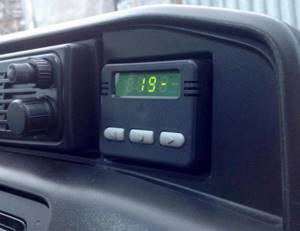
19 - these are malfunctions associated with the fuel pump due to open circuits or short circuits. Planar battery error codes 12 and 15 indicate a malfunction of the voltage regulator or battery. In both the first and second cases, the problem is related to the supply voltages.
Code 16 indicates insufficient ventilation. It does not provide cooling of the combustion chamber in the heater and the heat exchanger. Also, the flame sensor did not cool down during purging.
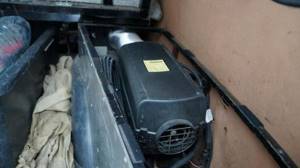
Planar autonomous vehicle errors with code 10 are problems with the air blower motor. It does not reach high speeds due to high friction in the bearings. 27 – the electric motor is jammed and does not rotate. 28 – the motor rotates, but at one constant speed. Autonomy codes "Planar" 02 - overheating according to the temperature sensor.
